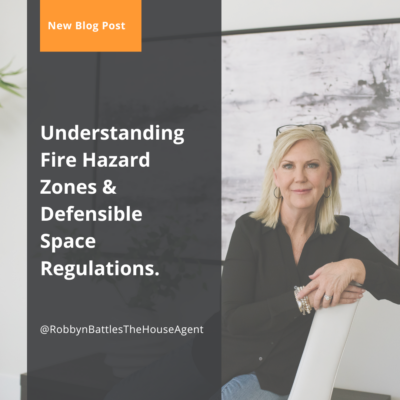 Fire Hardening & Home Sales: A Friendly Guide for Foothill Homeowners. Living in the beautiful Foothills—from Sylmar to Monrovia—offers stunning views and a close-knit community. However, wildfire preparation has become increasingly important with California’s evolving climate. Recent updates to fire hazard maps and defensible space regulations may impact your homeowner’s insurance and real estate transactions. This guide aims to help you understand these changes and take proactive steps to protect your home.
Fire Hardening & Home Sales: A Friendly Guide for Foothill Homeowners. Living in the beautiful Foothills—from Sylmar to Monrovia—offers stunning views and a close-knit community. However, wildfire preparation has become increasingly important with California’s evolving climate. Recent updates to fire hazard maps and defensible space regulations may impact your homeowner’s insurance and real estate transactions. This guide aims to help you understand these changes and take proactive steps to protect your home.
Understanding Fire Hazard Severity Zones (FHSZ)
California’s Fire Hazard Severity Zones (FHSZ) categorize areas based on wildfire risk:
- Moderate (Yellow)
- High (Orange)
- Very High (Red)
These classifications consider factors like vegetation, topography, and climate. Recent updates have expanded high-risk zones in many Foothill communities, including La Cañada Flintridge, La Crescenta, Altadena, and Pasadena.
Check Your Zone: Use the CAL FIRE FHSZ Viewer to see your property’s classification.
What Is Defensible Space?
Defensible space is a buffer between your home and surrounding vegetation, designed to slow or stop wildfire spread. Creating and maintaining this space is crucial for your safety and property protection.
Key Zones:
- Zone 0 (0–5 feet): Keep this area free of combustible materials.
- Zone 1 (5–30 feet): Maintain well-spaced, healthy vegetation.
- Zone 2 (30–100 feet): Reduce fuel by thinning trees and shrubs.
Regular maintenance of these zones enhances your home’s resilience to wildfires.
Selling Your Home? Understand the Requirements
This checklist is valuable whether you’re selling or simply maintaining your property.
If your property is in a High or Very High FHSZ and you’re selling, California law requires:
- Disclosure: Complete the C.A.R. Form FHDS to inform buyers about fire hardening and defensible space.
- Inspection: Obtain a defensible space inspection from your local fire department.
- Compliance: Address any issues identified in the inspection before closing.
Note: These requirements differ from annual brush clearance mandates.
California Association of Realtors Defensible Space Disclosure Checklist. When completing the FHDS form, you’ll need to address:
- FIRE HARDENING VULNERABILITIES: Seller is aware of the following features that may make the home vulnerable to wildfire and flying embers (check all that apply):
(1) □ Eave, soffit, and roof ventilation where the vents have openings in excess of one-eighth of an inch or are not flame and ember resistant.
(2) □ Roof coverings made of untreated wood shingles or shakes.
(3) □ Combustible landscaping or other materials within five feet of the home and under the footprint of any attached deck.
(4) □ Single pane or non-tempered glass windows.
(5) □ Loose or missing bird-stopping or roof flashing.
(6) □ Rain gutters without metal or noncombustible gutters
When completing the FHDS form, you’ll need to address:
- Construction Date: Was the home built before January 1, 2010?
- Fire-Resistant Features: Presence of ember-resistant vents, Class A roofing, etc.
- Defensible Space Compliance: Current status and any local ordinances.
- Inspection Reports: Availability of recent defensible space inspections.
Defensible space is the area around a building where vegetation and other combustible materials are cleared or reduced to slow fire spread and protect homes from wildfire.
Key Elements of Defensible Space:
- Hardscape: Use gravel, pavers, or concrete instead of mulch.
- Clearance: Remove dead plants, weeds, and debris from roofs, gutters, decks, and under structures.
- Tree Pruning: Keep branches 10 feet away from chimneys and stovepipes.
- Limit Combustibles: Reduce or relocate firewood, lumber, and other flammable items.
- Fire-Resistant Materials: Replace combustible fencing and other materials with fire-resistant options.
- Relocate Containers: Move garbage and recycling containers outside the defensible space zone.
- Separation: Maintain a clear gap between trees, shrubs, and flammable items like patio furniture.
Impact on Homeowners’ Insurance
Insurance companies consider FHSZ classifications when determining coverage and premiums. Homes in higher-risk zones may face increased rates or policy changes. Proactively creating defensible space and implementing fire-hardening measures can positively influence your insurability.
The Future of Building a Fire-Resilient HomeBuilding a fire-resilient home from scratch is one thing. Bringing older homes up to that heightened standard is a more daunting and costly challenge. A report from 2024 by the independent research group Headwater Economics put the cost to harden a two-story, 2,000 square-foot single-family home at anywhere from $2,000 to “more than $100,000.”
Some local governments offer grants and incentives to fire-wary homeowners hoping to make these upgrades. The insurance industry is beginning to offer discounts to some homeowners who make fire wise changes, though the promised savings are often smaller than many expect or demand. There aren’t any statewide plans to help harden California’s housing stock in masse, though a pilot project is underway and the Legislature is considering a few other ideas.
Beyond policy changes, California homeowners, planners, real estate agents, and developers may need to change their thinking about wildfire risk. Rather than viewing home hardening as a luxury expense or even a necessary cost that must be begrudgingly assumed, such protections might just need to become standard features of homeownership across the increasingly fire-prone American West.
Need Assistance?
If you’re unsure about your property’s fire hazard classification or need a copy of the FHDS form, don’t hesitate to contact me. I’m here to help you navigate these requirements and ensure your home is safe and compliant.
You can protect your home and community from wildfire risks by staying informed and taking proactive steps.
Thanks for reading, Robbyn Battles

